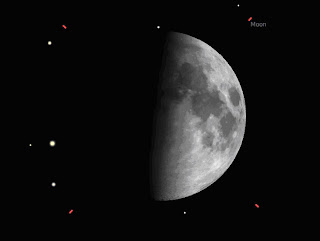Tech savvy teachers are always in need of some great activities and ideas to liven up their classrooms. Here is a great idea for teaching sixth graders about the phases of the moon. This activity and lesson helps to fulfill Utah’s Core Curriculum for 6th grade Science, Objective 1: Explain patterns of changes in the appearance of the moon as it orbits Earth. For this activity, students will need access to Stellarium and some fantastic cookies. Stellarium is a program that allows viewers to see what the sky looks like at any specific time and place. Stellarium helps to outline the constellations, view planets and moons close up, and explore other aspects of astronomy.
During this lesson, students will use Stellarium to capture screen shots of the different phases of the moon. Beginning at the current date, students will use the search function of Stellarium to find the moon and zoom into a close view. Fast-forwarding through time students will look first find the next full moon. They will then look for each of the other phases of the moon. As each phase is reached, students will return to real time to take a screen shot, as directed by the teacher. As each screen shot is taken, students will make note of the date that phase of the moon. These screen shots will then be arranged into a cycle of the moon with the use of Microsoft Word. Below, screen shots taken in February through March 2009 are shown with the appropriate date and phase of the moon.

February 12, 2009
Waning Gibbous
February 15, 2009
Last Quarter
February 19, 2009
Waning Crescent
February 23, 2009
New Moon
February 28, 2009
Waxing Crescent
March 4, 2009
First Quarter
March 8, 2009
Waxing Gibbous
March 11, 2009
Full Moon
Full Moon
Waning Gibbous
Last Quarter
Waning Crescent
New Moon
Waxing Crescent
First Quarter
Waxing Gibbous
















Very cool lesson plan! I think it is especially fun and interesting when children get to not only use Stellarium, but also eat cookies! How fun!
ReplyDeleteThis is a great way of showing the phases of the moon. It is very rarely that a person could stop what they are doing and observing that process every night. With the help of Stellarium you were able to show in a capsule the phases of the moon. Great job!
ReplyDeleteThis is great! I love the cookie idea. Using the computer program alone would probably be a little too abstract for the kids, so it's great you used something else that's fun and tangible.
ReplyDelete